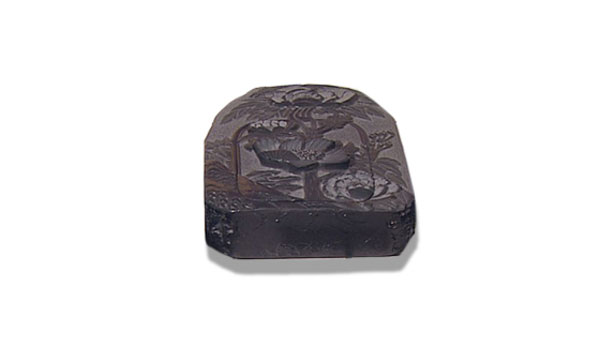
- Writing tools
- Miyagi
Ogatsu inkstone Ogatsu suzuri
Beautiful smoky lustrous black
A calligrapher's perfect companion
Description
What is Ogatsu inkstone ?
Ogatsu inkstone (called Ogatsu suzuri in Japanese) is a craft produced in the former town of Ogatsu (now city of Ishinomaki), Miyagi prefecture, where artisans still carefully hand carve and polish every piece.
What is unique to Ogatsu inkstone is its smoky black natural patterns. Also, the quality is dependable as inksticks (solid ink) can be grinded smoothly with good ink production.
Ogatsu stone is a black hard slate which is known for being resistant to compression and bending with low water absorption. Therefore the slate is also used for roofing tiles and building constructive material. Recently it has started being used for serving plates and other tableware.
The production of Ogatsu inkstone was temporarily suspended due to the 2011 earthquake off the Pacific coast of Tohoku followed by a tsunami. Fortunately, neither the technology nor the quarries were lost, and the production was restored and helped with reconstruction of the region.
History
Ogatsu inkstone dates back to the Muromachi period (1336-1573). Scholars believe that the inkstone already existed around that period because the term suzuri hama was mentioned in a history book from 1396, with suzuri meaning "inkstone", though this cannot be stated with certainty. There is also an anecdote from the Edo period (1603-1868) that the lord of Sendai domain, Masamune DATE was very pleased to be gifted an Ogatsu inkstone. An inkstone was discovered in his grave, so it can be inferred that it was one of his treasured possessions. The artisans were appreciated by the lord's son as well and they finally became employed by the Sendai domain. Not only artisans, but the quarries were placed under the protection of the domain. Under the protection of the Sendai domain and with an abundance of good quality quarried slate, the inkstone industry thrived. According to a book called Honai Fudoki (containing descriptions of regional climate and culture), Ogatsu inkstones became a local specialty and were valued as quality items. In 1985, Ogatsu inkstone was registered as a Japanese Traditional Craft. The techniques to make beautiful and practical Ogtatsu inkstones have remained alive and well.
General Production Process
 Photo:Miyagi Prefecture Tourism Division
Photo:Miyagi Prefecture Tourism Division
- 1. Cutting and smoothing
Each inkstone is made from a small slab of stone. The stone is quarried from an open-cut mine and cut down to the size of the future inkstone.
After the cutting, the rough surface is smoothed using river sand and water. An outline of the inkstone is created on the periphery, and the edges are carved using chisels called hori nomi or komaru nomi.
The interior of the inkstone has two main parts including a deep part for the ink pool ("the sea" in Japanese) and a flat section for rubbing the ink stick or ink bank ("a hill" in Japanese). Both sections have many other poetic names such as kenkai (inkstone sea), bokuchi (ink pond), gensho (inkstone marsh), suichi (water pond), or ike (pond) for the ink pool and riku (land), bokudo (ink shrine) and bokudo (ink path) for the flat section.
- 2. Rough carving
During this step, the ink pool and bank are carved roughly along with the completed edge.
A large chisel called kuri nomi that requires craftsmen to carve with the strength of their whole bodies is used.
Any decorative engravings on the edge or other parts of the inkstones are applied after the rough carving.
- 3. Carving the ink pool
The ink pool part is fully carved out. Also, a gentle slope from the bank to the ink pool is carved. The dimensions of the ink pool are traditionally one third of the area of the whole inkstone and the deepest part is two thirds of the inkstone's thickness. While carving, the craftsman uses their hands to check the depth, area, and smoothness of the slope.
- 4. Polishing
This process finalizes the shape while smoothing the surface.
It consists of inner, outer, and final polishing. For each stage, a different whetstone and water resistant paper are used.
- 5. Leveling the bottom
The bottom of the inkstone must be smoothed to be absolutely flat and even to ensure the inkstone is stable for use.
- 6. Finishing
There are three ways to finish the inkstone. The first is to apply a beautiful high gloss with Japanese lacquer.
The second way is a matte firing finish by applying a lacquer coating and firing the inkstone after to remove the shine.
The third one involves applying an ink finish instead of lacquer. All three methods increase the durability of the inkstone and appeal to different tastes.
See more Writing tools
- Kumano brushes
- Ogatsu inkstone
- Akama inkstone
- Unshu abacus
- Banshu abacus
- Nara brushes
- Suzuka inksticks
- Toyohashi brushes
- Kawajiri brushes
- Nara Ink































































































































































































































































































